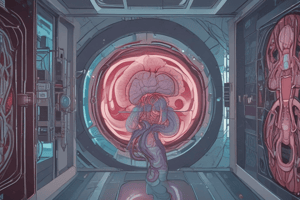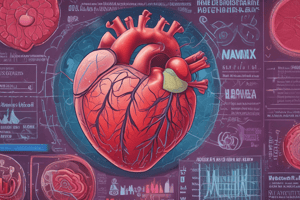Podcast
Questions and Answers
What is the reason that slowly developing occlusions are less likely to cause infarction?
What is the reason that slowly developing occlusions are less likely to cause infarction?
- They provide time for the development of alternative pathways of flow. (correct)
- The affected tissue undergoes irreversible damage at a slower pace.
- The red cells are lysed at a slower rate in slowly developing occlusions.
- Slowly developing occlusions do not influence the likelihood of infarction.
Which organ does not become pale after an infarct due to extensive blood presence?
Which organ does not become pale after an infarct due to extensive blood presence?
- Myocardium
- Lung (correct)
- Liver
- Spleen
What type of necrosis is the pathognomonic change in all infarcts?
What type of necrosis is the pathognomonic change in all infarcts?
- Fat necrosis
- Liquefactive necrosis
- Caseous necrosis
- Coagulative (ischaemic) necrosis (correct)
Which type of occlusion causes pale infarcts?
Which type of occlusion causes pale infarcts?
Which organ after infarction is most likely to be replaced by fibrosis?
Which organ after infarction is most likely to be replaced by fibrosis?
What makes pulmonary infarcts unique in terms of color changes?
What makes pulmonary infarcts unique in terms of color changes?
What is the most common cause of myocardial or cerebral infarction according to the text?
What is the most common cause of myocardial or cerebral infarction according to the text?
Which type of infarction is more likely to occur in solid organs like the heart, spleen, and kidney?
Which type of infarction is more likely to occur in solid organs like the heart, spleen, and kidney?
What is the immediate consequence after obstruction of the blood supply during pathogenesis, according to the text?
What is the immediate consequence after obstruction of the blood supply during pathogenesis, according to the text?
What determines whether occlusion of a vessel will cause damage, as stated in the text?
What determines whether occlusion of a vessel will cause damage, as stated in the text?
Which part of the body experiences more marked edema and hemorrhage following an infarction, according to the text?
Which part of the body experiences more marked edema and hemorrhage following an infarction, according to the text?
What type of infarction occurs in double circulation organs and is mostly due to venous occlusion?
What type of infarction occurs in double circulation organs and is mostly due to venous occlusion?
Flashcards are hidden until you start studying
Study Notes
Infarction
- Definition: Localized area of ischemic necrosis caused by occlusion of either the arterial supply or the venous drainage
- Causes of infarction: thrombi and emboli, local spasm of the artery or torsion of vessels, extrinsic compression of vessel by tumor, traumatic rupture of the artery
- 40% of all deaths in the United States are caused by cardiovascular disease, with most being attributable to myocardial or cerebral infarction
Types of Infarction
- Pale infarcts: occur in solid organs, due to arterial occlusion, examples: heart, spleen, kidney
- Red infarcts: occur in double circulation, mostly due to venous occlusion, examples: lung and small intestine
Pathogenesis
- Local anoxemic occurs immediately after obstruction of the blood supply
- Within few hours, affected part becomes swollen due to edema and hemorrhage, with variable amount depending on organ
- Cellular changes such as swelling and degeneration appear early, while death of cells or necrosis occurs in 12-48 hours
Factors Affecting Infarction
- Rate of development of occlusion: slowly developing occlusions are less likely to cause infarction due to development of alternative pathways of flow (collateral circulation)
- Vulnerability of hypoxia: susceptibility of a tissue to hypoxia influences likelihood of infarction, examples: neurons undergo irreversible damage, myocardial cells die after 20-30 minutes, skeletal muscles can survive longer
Organ-Specific Infarction
- Pulmonary infarction: hemorrhagic, roughly wedge-shaped, and never becomes pale due to extensive amount of blood
- Splenic infarction: hemorrhagic, roughly wedge-shaped
- Myocardial infarction:
- Renal infarction: replaces with fibrosis
- Cerebral infarcts: characteristic liquefactive necrosis
Microscopic Changes
- Pathognomic change in all infarcts: coagulative (ischaemic) necrosis of the affected area of tissue or organ
- In cerebral infarcts: characteristic liquefactive necrosis
Studying That Suits You
Use AI to generate personalized quizzes and flashcards to suit your learning preferences.





